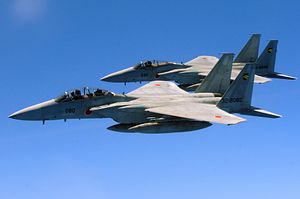Japan’s Air Self Defense Force (JASDF) might face a shortage of fighter jets in the 2020, unless Tokyo accelerates upgrading its fleet of legacy aircraft and expands the scope of current modernization efforts, Defense News reports.
Japan is the largest customer of the F-15 all-weather air superiority fighter outside the United States and had 223 planes built under license by Japanese defense contractor Mitsubishi Heavy Industries. It also fields 94 Mitsubishi F-2, a 4.5th generation multirole fighter based on Lockheed Martin’s F-16, as well as approximately 70 F-4 Phantom II jets.
While Phantom II jets are already being slowly phased out, the retirement of the JASDF’s F-15 and F-2 fleets will begin in the 2020s, although some of the F-15s could potentially remain in service until the 2030s.
However, despite the JASF investing in extensive fighter upgrades – “including modifying eight units of its F-15 fleet and improving air-to-air combat capabilities of its F-2”, according to Defense News – the JASDF might be confronted by a shortage of fighter jets in a few years.
“[T]he JASDF could face a severe force structure crunch in the next decade,” states Richard Aboulafia, vice president, analysis, at the Teal Group, citing the slow pace and the small numbers of planes currently being upgraded.
Aboulafia, however, does praise the JASDF’s decision to procure 42 F-35 Lightning II Joint Strike Fighters back in December 2011, the first of which the JASDF is scheduled to receive at the end of 2016:
It’s tough to compare the F-35 with other planes. The traditional performance metrics of speed and time-to-climb, maneuverability, range, and payload don’t look particularly great. It does offer stealth and much greater sensor capabilities, and sensor fusion. In effect, going with the F-35 means an air service is comfortable with a stealthy, very well connected combat hub, rather than a traditional hot rod bristling with weaponry. But given their sensor and situational awareness attributes, even having a few score of them will provide a meaningful enhancement of the JASDF’s capabilities.
The F-35 Joint Strike Fighter procurement is an interim solution until Tokyo can field its own indigenous fifth generation fighter. The Japanese Ministry of Defense Technical Research and Development Institute (TRDI) is currently working on developing an indigenous stealth fighter aircraft, the Mitsubishi ATD-X Shinshin. However, the plane is not supposed to enter service until the late 2020s and Aboulafia does not believe that 42 planes will suffice for the JASDF’s needs and the slow modernization pace and lack of alternatives “almost guarantees further F-35 procurement,” he notes.
Yet Defense News quotes an unnamed Japan-based defense analyst who emphasizes that replacing the F-15 will remain a problem – despite the acquisitions of F-35 Join Strike Fighters – and that the aircraft might have to remain in service for longer than planned:
The F-2 is a terrible aircraft, just ask the JASDF. It needs to be mothballed and the money being spent on it moved over to F-15. But there is no replacement for F-15. The F-22 would have been that replacement [and would have meant Japan would not have bought the F-35]. Japan’s F-15s have decades of fatigue life left on them. They just have to spend money on the internal organs. The USAF is going to fly their Eagles in an air superiority role until 2040. Japan has the opportunity to work directly with the USAF to reduce costs and develop the technologies both countries need.

































